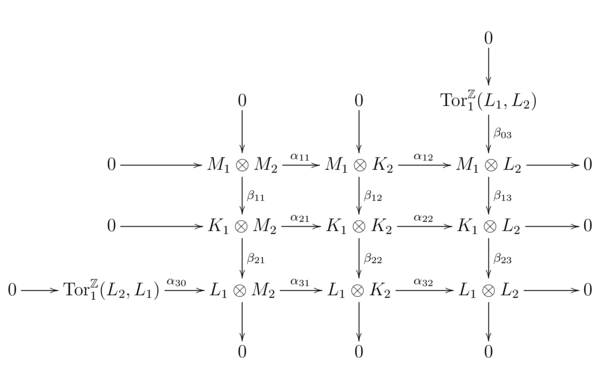Tor functor
In homological algebra, the Tor functors are the derived functors of the tensor product of modules over a ring. They were first defined in general to express the Künneth theorem and universal coefficient theorem in algebraic topology. For abelian groups, Tor is related to the notion of a torsion subgroup, which explains the notation.
Definition
Specifically, suppose R is a ring, and denote by R-Mod the category of left R-modules and by Mod-R the category of right R-modules (if R is commutative, the two categories coincide). Pick a fixed module B in R-Mod. For A in Mod-R, set T(A) = A ⊗R B. Then T is a right exact functor from Mod-R to the category of abelian groups Ab (in the case when R is commutative, it is a right exact functor from Mod-R to Mod-R) and its left derived functors LnT are defined. We set
i.e., we take a projective resolution
then remove the A term and tensor the projective resolution with B to get the complex
(note that A ⊗R B does not appear and the last arrow is just the zero map) and take the homology of this complex.
Properties
- For every n ≥ 1, TorR
n is an additive functor from Mod-R × R-Mod to Ab. In the case when R is commutative, we have additive functors from Mod-R × Mod-R to Mod-R. - As is true for every family of derived functors, every short exact sequence 0 → K → L → M → 0 induces a long exact sequence of the form
- If R is commutative and r in R is not a zero divisor then
- from which the terminology Tor (that is, Torsion) comes: see torsion subgroup.
- TorZ
n(A, B) = 0 for all n ≥ 2. The reason: every abelian group A has a free resolution of length 1, since subgroups of free abelian groups are free abelian. So in this important special case, the higher Tor functors vanish. In addition, TorZ
1(Z/kZ, A) = ker(f) where f: A → A represents "multiplication by k". - Furthermore, every free module has a free resolution of length zero, so by the argument above, if F is a free R-module, then TorR
n(F, B) = 0 for all n ≥ 1. - The Tor functors preserve filtered colimits and arbitrary direct sums: there is a natural isomorphism
- From the classification of finitely generated abelian groups, we know that every finitely generated abelian group is the direct sum of copies of Z and Zk. This together with the previous three points allows us to compute TorZ
1(A, B) whenever A is finitely generated. - A module M in Mod-R is flat if and only if TorR
1(M, –) = 0. In this case, we even have TorR
n(M, –) = 0 for all n ≥ 1. In fact, to compute TorR
n(A, B), one may use a flat resolution of A or B, instead of a projective resolution (note that a projective resolution is automatically a flat resolution, but the converse isn't true, so allowing flat resolutions is more flexible). - Symmetry: if R is commutative, then there is a natural isomorphism TorR
n(L
1, L
2) ≅ TorR
n(L
2, L
1). Here is the idea for abelian groups (i.e., the case R = Z and n = 1). Fix a free resolution of L
i as follows
- so that M
i and K
i are free abelian groups. This gives rise to a double-complex with exact rows and columns

- Start with x ∈ TorZ
1(L
1, L
2), so β03(x) ∈ ker(β13). Let x
12 ∈ M
1 ⊗ K
2 be such that α12(x
12) = β03(x). Then
- i.e., β12(x
12) ∈ ker(α22). By exactness of the second row, this means that β12(x
12) = α21(x
21) for some unique x
21 ∈ K
1 ⊗ M
2. Then
- i.e., β21(x
21) ∈ ker(α31). By exactness of the bottom row, this means that β21(x
21) = α30(y) for some unique y ∈ TorZ
1(L
2, L
1).
- Upon checking that y is uniquely determined by x (not dependent on the choice of x
12), this defines a function TorZ
n(L
1, L
2) → TorZ
n(L
2, L
1), taking x to y, which is a group homomorphism. One may check that this map has an inverse, namely the function TorZ
n(L
2, L
1) → TorZ
n(L
1, L
2) defined in a similarly manner. One can also check that the function does not depend on the choice of free resolutions.